You’re not alone if you have trouble visualizing, measuring, and controlling your cloud computing costs. Whether you run workloads on a public or private environment, cloud computing can add to your cost problem.
That’s because cloud computing offers on-demand resources, so misconfigured infrastructure, an overzealous engineer, or a blindsided operations team can do something that leads to a surprise cloud bill at the end of the month.
But not so fast. What is cost optimization, and why is it different from reducing IT costs at all cost?
Table Of Contents
- What Is Cost Optimization?
- What Is The Difference Between Cost Optimization And Cost Reduction?
- Why Is Cost Optimization Important Now?
- What Questions Can Cost Optimization Help Answer?
- What Are Some Cost Optimization Examples?
- The Four Pillars Of Cost Optimization
- 8 Cost Optimization Best Practices To Implement ASAP
- What Next: Optimize Your Cloud Costs WIth Cost Intelligence
What Is Cost Optimization?
The goal of cost optimization is to identify and reduce wasteful spending, underutilization, and low return on IT budgets.
Cloud cost optimization enables businesses to lower their cloud costs while also achieving better performance. It involves streamlining processes, optimizing workloads, and using automation to manage resources more efficiently.
What is cloud cost optimization then?
In organizations that use the cloud, reducing cloud waste and enabling optimal cloud operations at any scale is called cloud cost optimization.
Cost optimization in the cloud combines strategies, techniques, best practices, and tools that reduce cloud costs while maximizing business value.
Optimizing costs in the cloud involves:
- Identifying and reducing mismanaged or excess resources
- Taking advantage of discounts to procure more resources for less, and
- Rightsizing computing resources to specific workload and application requirements to reduce cloud waste
Key takeaway: Cost optimization is the continuous practice of enabling optimal business operations while ensuring cost efficiency. The goal of any cost optimization model is to reduce waste to yield more savings in order to finance growth-oriented initiatives, like releasing improved feature updates.
So, are cost optimization and cost reduction the same thing?
What Is The Difference Between Cost Optimization And Cost Reduction?
Cost reduction differs significantly from cost optimization in that it focuses on reducing costs, often at any cost, in order to reduce cloud expenditure.
Meanwhile, the goal of cost optimization is to reduce unnecessary costs so you can redirect the savings to areas that will have a higher return on investment. Alternatively, the savings can be passed on to customers through lower prices for products or services, which makes them more competitive.
In practice, reducing cloud usage indiscriminately just to reduce your cloud bill can adversely affect system performance, impede engineering innovation, and limit overall business growth.
Here’s an example:
Onboarding more customers often indicates business growth. However, more customers require more resources to support, increasing your cost of goods sold (COGS).
In this case, cost reduction is likely to focus on cutting costs by either stagnating or reducing the number or type of customers you onboard. Conversely, cost optimization techniques like unit cost analysis would focus more on identifying ways to leverage economies of scale to protect or improve margins on each customer you onboard.
Moreover, cost reduction is often a short-term technique to cut spending. In contrast, cost optimization is often a long-term, continuous process to reduce unnecessary spending so that you can maximize investment in areas that yield the most return on investment.
Key takeaway: Although cutting back on expenses might sound appealing, pursuing cost optimization over the long run will be a much better investment for your organization.
Why Is Cost Optimization Important Now?
Cost optimization has many benefits, including cost control and waste reduction, both in the cloud and in physical data centers. Cost optimization can be a great way to build a scalable, modern infrastructure that meets the demands of your workloads without going over budget.
Picture this.
Gartner predicts cloud spending to grow to almost $500 billion in 2022 and $600 billion in 2023.
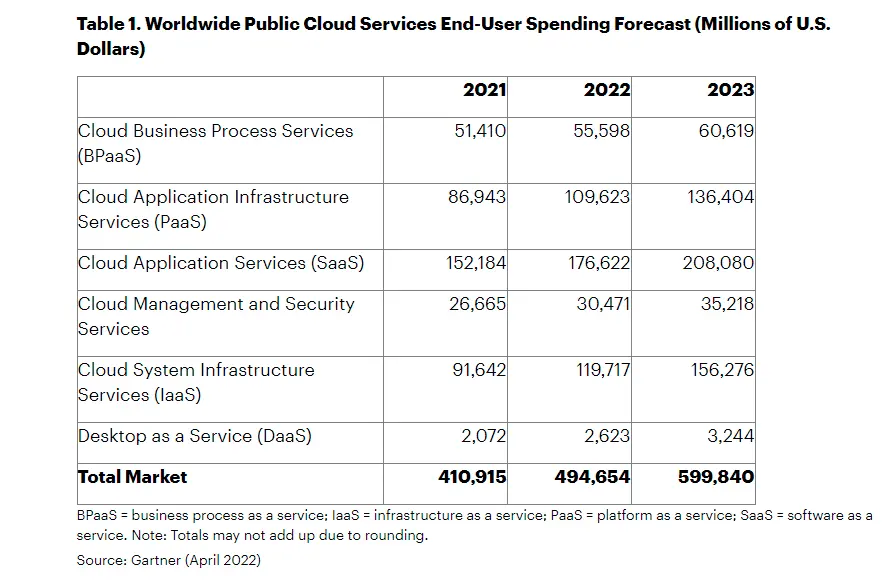
Credit: Gartner
By 2026, public cloud spending could account for more than 45% of all enterprise IT spending. Considering public cloud spending was less than 17% in August 2021, that is quite a jump.
IDC also forecasts that cloud spending will continue to grow strongly through 2025 on the back of reinvigorated growth in Q3 2021.
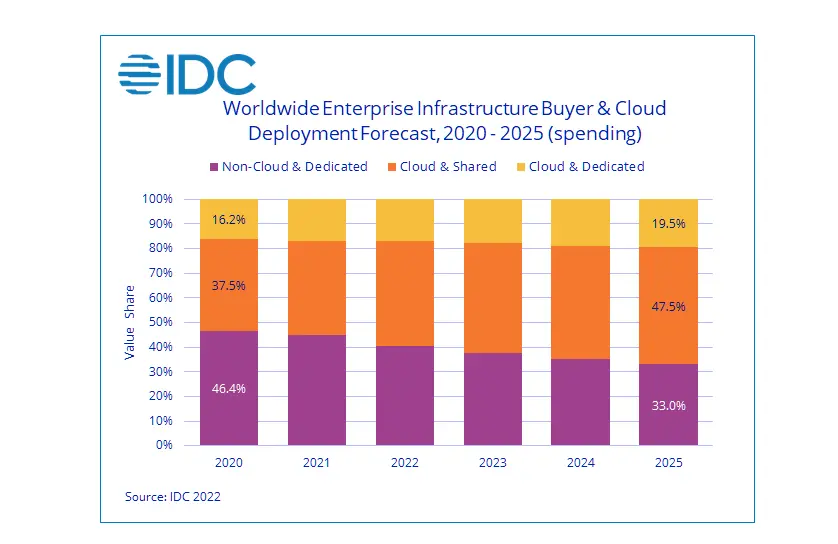
Credit: IDC
Cloud waste also increased 2% in 2021, from 30% in 2020 to 32% in 2021, according to another state of the cloud study released in Q1 2022.
With the four studies pointing to IT costs as a major expense center, cost optimization can help ensure you are not wasting up to a third of your IT budget. But how?
You can, for example, track costs over time to see how they relate to your business activities. Good cost optimization strategies help make sense of who, what, and why your IT costs are changing.
Ideally, you want cloud costs to go flat or increase only marginally as your client base grows. But if your costs rise faster than or as quickly as you onboard customers, you may have a problem to address.
What Questions Can Cost Optimization Help Answer?
Cost optimization seeks answers to questions such as:
- How much does each product feature cost to develop and operate? How does that impact our margins?
- Are our margins higher on specific product lines than on others?
- What is the unit cost of different units of value?
- How do our costs change over time across different teams and initiatives?
- Were we able to save money by refactoring this application?
- How much would our costs increase if we added ten customers tomorrow?
- How do we utilize economies of scale more?
- Is it possible to improve our cost per unit value by making particular trade-offs?
- What is our utilization cost per customer per feature?
- Which product feature do we need to move to a higher pricing tier to maximize our gross margin?
- What is our most valuable customer segment so we can target it more effectively?
- Are we spending more on AWS because we’re growing faster? Or are we just overspending?
Your questions might be more or less similar to these, depending on your specific objectives. In either case, a good cost optimization strategy can help you do more than just tell whether your total monthly IT expenses increased or decreased.
So, what does cost optimization look like in operation?
What Are Some Cost Optimization Examples?
You can use various cost optimization techniques to reduce computing costs without negatively affecting your system’s performance or engineering velocity. Some strategies include:
Modernize
Legacy systems often consume a great deal of computing power. One option could be to use a public cloud. Cloud computing allows you to immediately reduce hardware and software licensing expenses while improving the performance of your system since the cloud service provider handles those aspects.
Cloud-native design
You do not want to just lift and shift workloads to the cloud. You may reintroduce previous inefficiencies into your new cloud environment, leading costs to increase or remain the same. If you have resources and skills already, it may be more effective to refactor your apps to a cloud-native design. Alternatively, you could use other incremental cloud migration strategies to optimize costs over time.
Rightsizing
This involves analyzing and scaling computing resources to the most efficient size suitable for a given use case. You can optimize servers based on RAM, database, vCPU performance, graphic performance, storage, and network throughput. Autonomous rightsizing tools like ProsperOps can also suggest changes across instance types to optimize performance and costs.
Utilize cloud provider discounts
Cloud providers offer a variety of discount programs to help customers get more business value for less. AWS, for example, offers AWS Savings Plans and Reserved Instances. You can save as much as 75% off of regular On-Demand pricing in both cases.
Using an automation tool like ProsperOps, which rightsizes your resources, purchases the right instances, and finds the right discounting program for your workload, can simplify your work.
Take advantage of Spot instances With a tool like Xosphere, you can continuously switch your system from a pricey On-Demand model to the cheaper Spot Instances whenever they are available.
End unused resources
By monitoring server load metrics, you’ll be able to figure out when activity is at its lowest, so you can switch off idle instances without affecting customer experience. Another way to do it is to terminate compute instances when you are away, such as during weekends or nights, if your organization does not work at such times.
Enabling cost anomaly detection
You can use a platform like CloudZero to detect abnormal costs in real time before they become costly surprises. Without such a system in place, many businesses face surprise cloud bills at the end of the billing cycle, often weeks after they occur.
Develop a cost-conscious culture
This is a long-term strategy designed to help engineering, finance, and management professionals treat costs in the same way they do uptime and the Mean Time To Recover (MTTR) — like the first-class metric it is. When you make cost a conscious consideration, you can gradually motivate your teams to develop new ways to reduce costs without degrading performance.
Tip: You can see more cost optimization success stories from top companies like Drift (saved $2.4 million), Obsidian (cut AWS spend by 25%), and Response Tap (reduced AWS spending by 18%) linked above.
Next, let’s look at the pillars of cost optimization you can implement to improve your IT spending.
The Four Pillars Of Cost Optimization
The following four cost optimization principles apply across virtually all environments, regardless of workload or architecture. According to AWS, the pillars of cost optimization are:
- Rightsize resources – Ensure the resource provisions you make are in line with your workload’s needs. Typical compute resources to rightsize include vCPU, RAM, network bandwidth, and storage capacity.
- Use Reserved Instances where most suitable – For example, if you are an AWS customer, you can get up to 75% off the On-Demand price by picking RIs for predictable workloads. Or, you can use Spot Instances for variable workloads.
- Improve elasticity – In the cloud, you can optimize costs by turning resources off when not needed. You can also leverage auto-scaling to increase and decrease capacity as and when needed.
- Measure, monitor, and improve – This includes defining and enforcing cost allocation tagging, defining metrics, setting targets, continuously reviewing results, training teams to create cost-effective solutions (with incentives at each milestone), and appointing individuals or teams to be responsible for cost optimization.
So, what else can you do immediately to optimize costs?
8 Cost Optimization Best Practices To Implement ASAP
Implement these cost optimization best practices to maximize business value without incurring additional costs.
- Digitalize IT and business operations to support cost optimization automation.
- Get the best pricing and terms for all business purchases. You can use tools like ProsperOps and Xosphere to automate RIs and Savings Plans optimization and Spot Instances orchestration, respectively.
- Enable continuous cost monitoring to improve cloud cost visibility. That way, you can tell precisely where to cut costs without compromising system performance and customer experience.
- Utilize these cloud cost monitoring best practices to detect and fix cost anomalies as soon as they arise. This can help prevent overspending.
- Find out where your organization is wasting cloud resources.
- Create and enforce cost governance policies that inform your team under what circumstances it should shutdown workloads or flag instances as idle. That way, you can avoid running instances unnecessarily.
- Rightsize AWS cloud resources to avoid over-provisioning (waste) or under-provisioning (degrading performance or service availability).
- See if these hidden AWS cost savings opportunities apply to your use cases.
You can explore more cost optimization best practices here.
What Next: Optimize Your Cloud Costs With Cost Intelligence
When you don’t know who, what, and why your SaaS costs are changing, it’s hard to optimize them. Measuring your cloud costs per unit is the best way to determine exactly what’s driving them.
Unlike conventional cost tools, CloudZero reports granular, immediately actionable insights. There are up to 12 cost dimensions to choose from, including Cost per customer, Cost per team, Cost per feature, and many more.
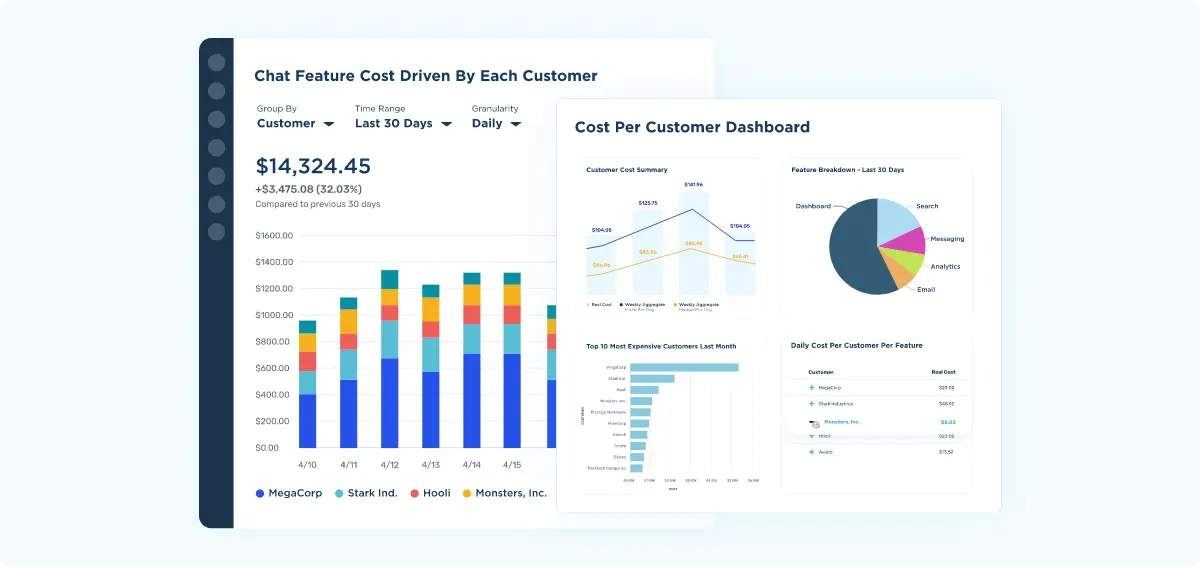
CloudZero is the first cloud costs optimization platform that gives your engineers detailed, yet intuitive cost insights. Costs can be displayed in your engineers’ own language, such as cost per deployment, cost per feature, cost per environment, cost per service, cost per development team, and more.
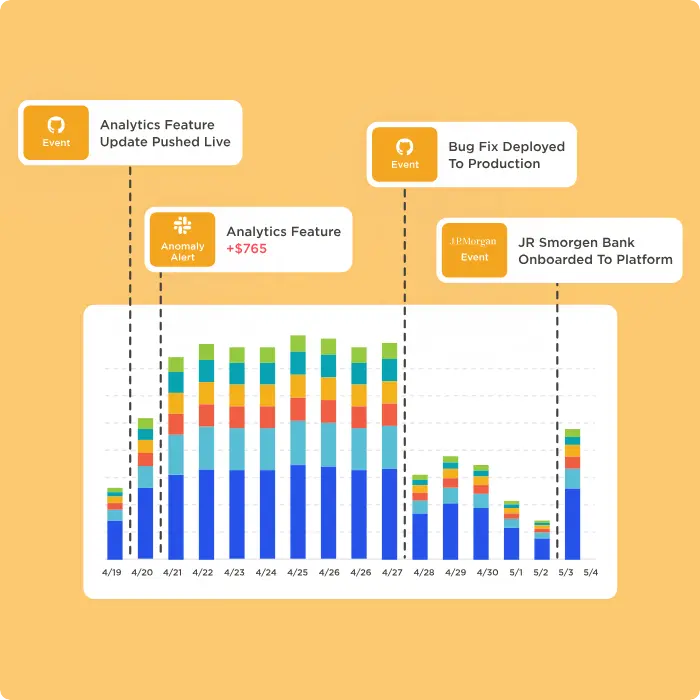
This can help them track the effects of their architectural decisions in near-real-time, preventing cost overruns and learning to design cost-effective solutions.
Besides, CloudZero delivers these kinds of user-friendly and practical cost metrics in the language of finance (cost per customer, per project, per service/product, etc) and FinOps (Cost of Goods Sold, gross margin analysis, etc).
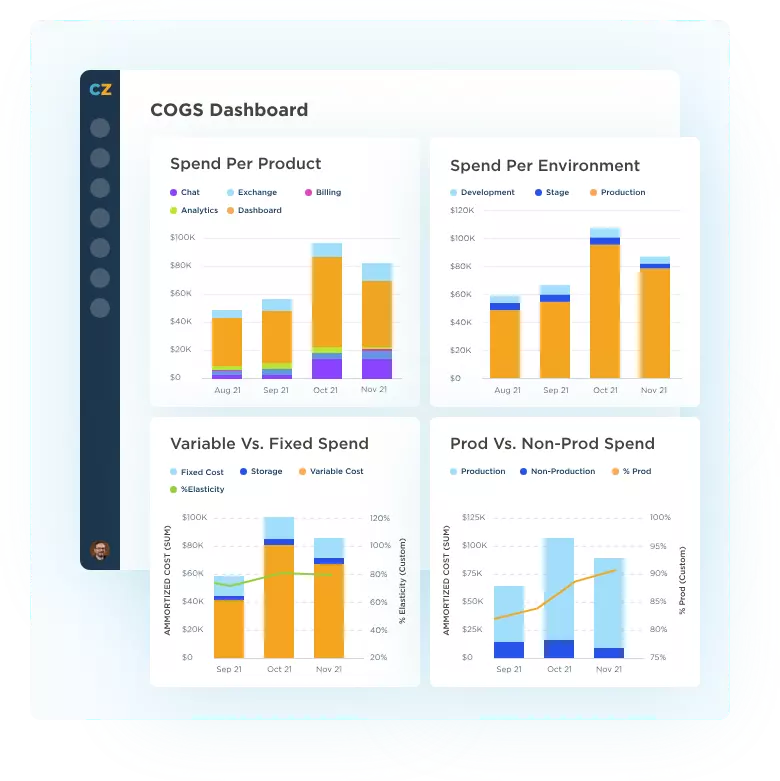
With CloudZero, you’ll have the only cost optimization platform that enables you to view granular Kubernetes costs alongside AWS, Azure, GCP, and Oracle Cloud cost information.
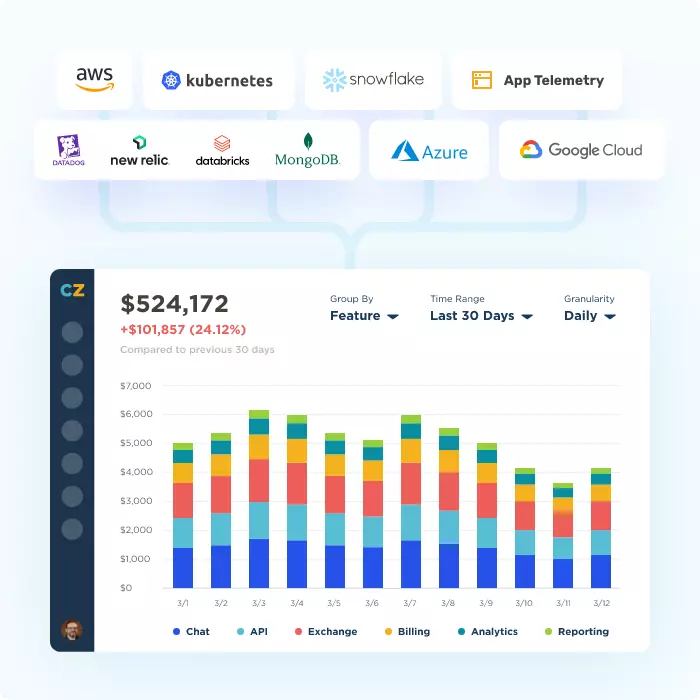
CloudZero is a true single pane of glass for cloud costs because you can also view, compare, and optimize costs across platforms, including Databricks, Snowflake, Datadog, MongoDB, and more.
Yep, we’ll also send you timely, noise-free, and context-rich notifications about cost anomalies, ensuring you don’t get hit with a surprise bill.
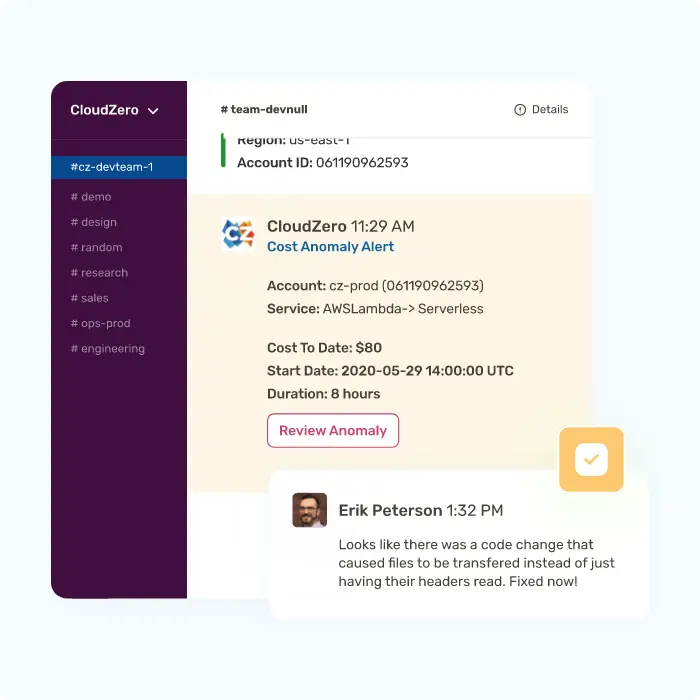
Don’t just take our word for it. CloudZero helped Drift has save over $4 million. Remitly now allocates 50% more cloud costs without tagging. And, Malwarebytes saves 6-9 hours per week managing cloud costs since switching to CloudZero. Here’s your chance.
 , customize it for your environment, and experience CloudZero in action for yourself.
, customize it for your environment, and experience CloudZero in action for yourself.








